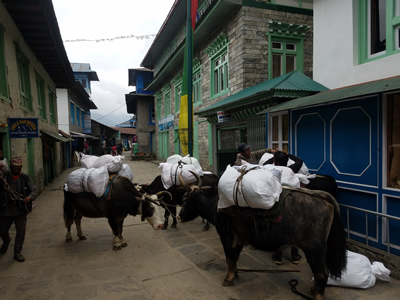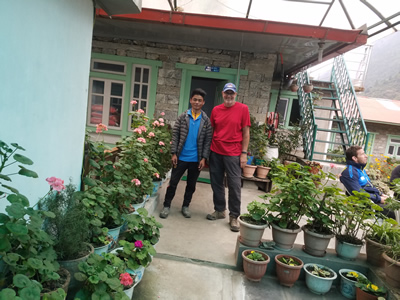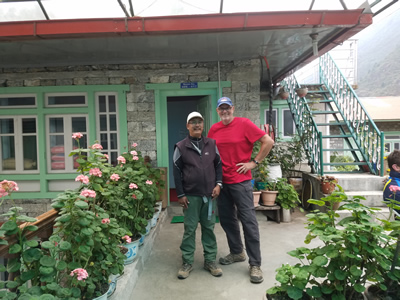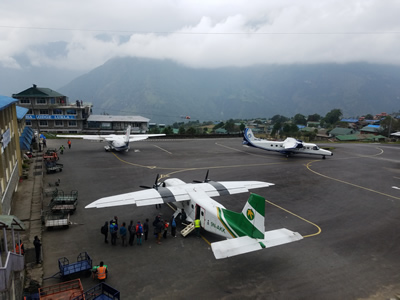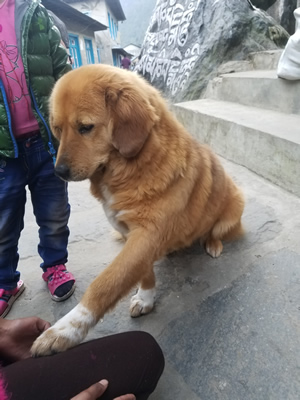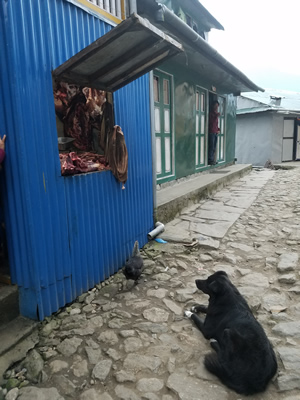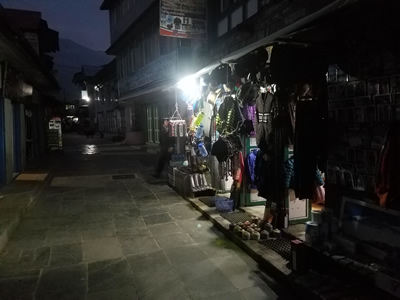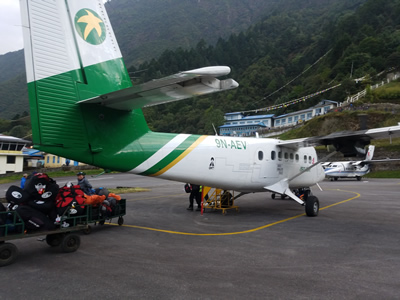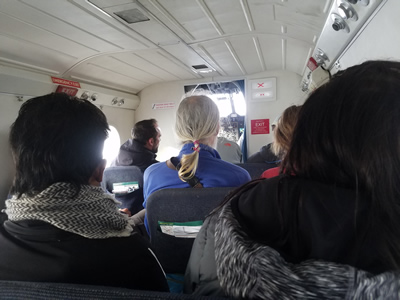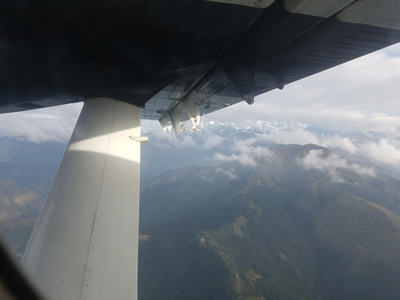Nepal Pt15: Tenzing-Hillary Airport
Most climbers and trekkers going to the Everest region start walking from the Tenzing-Hillary Airport in Lukla. It cuts out several days of hiking up approach valleys. Just a forty five minute flight from Kathmandu and you are in the mountains. From Lukla, it's only two short days of walking to reach Namche Bazaar.
It wasn't always so quick and easy to reach the Khumbu region. I've read many books about the classic climbing expeditions to Everest and other Himalayan peaks during the 1960's, 70's and 80's. Back then it took two weeks to walk to the base of the mountain from Junbesi, the town at the end of the road. Mountaineers used the approach march to help them acclimatize before high altitude climbs. Some, like the famous British climber Don Whillans, a notorious smoker and drinker, even counted on the approach march to get in shape. In those days mountaineers weren't super athletes who were constantly training.
But each year the road was extended a little bit farther. When I went to Nepal for the first time in 1990 we were able to drive to the town of Jiri. From there it took about a week to walk to Namche. Now in 2017, Shambu and I were able to take a bus to Salleri. Starting from there, we arrived in Namche Bazaar on the fifth day of our trek.
Most foreign tourists who visit Nepal have limited time. They don't want to spend ten days trekking in and out of the mountains so they fly to and from Lukla. It's become such a lucrative business that the Nepal government has stated that it will never extend the current road any closer to Namche. Five airlines operate flights between Kathmandu and Lukla: Nepal Airlines, Simrik Airlines, Tara Air, Sita Air and Summit Air. The entire town of Lukla is built around the Tenzing-Hilary airport. Its economy is totally dependent on it.
Lukla is an unlikely place for an airport. It's built on a shelf on the side of a mountain that forms one wall of the deep valley of the Dudh Khosi River. Flights can only operate when there is good visibility. To reach Lukla, planes have to fly up the valley well below the level of the mountaintops and then turn to line up with the runway for their final approach. There isn't much space so the runway is short, only 1729 feet long. By comparison, the main runway at the Boise airport is almost 10,000 feet long (9763 feet to be precise).
The runway takes up all of the available space on the mountainside. At one end is a steep hillside that drops to the river. This makes takeoffs exciting as planes basically fly off the edge of a cliff. At the other end of the runway is the mountainside that rises high above Lukla. A plane that's landing heads straight at a stone wall. Once it touches down, it stops one way or another. The runway is sloped at 12 degrees to help aircraft slow down on landing and speed up on takeoff.
The airport is quite high at 9338 feet so the air is thin and wings provide less lift than at most other airports. That means more runway is needed to land and take off which makes the short field even more of a challenge. The only aircraft that can use the Lukla airport are small planes designed specifically for short field landings and takeoffs, like the Dornier 228 or DHC-6 Twin Otter.
Or the C5 Galaxy. (-:
Even in a STOL (Short TakeOff and Landing) aircraft it is very difficult to abort a landing or a takeoff because of the steep slopes at each end of the runway. In addition to everything else, the winds can be unpredictable because of the mountains. When all of these factors are considered, Lukla is usually included whenever someone writes about the most dangerous airports in the world. Often it even makes the top of the list. That doesn't seem to deter travelers. Flying in and out is very dependent on the weather (as I learned on this trip) but when the weather is good there are flights going in and out constantly as you can see in the video. (WARNING: It's a really big file.) According to the Civil Aviation Authority of Nepal (CAAN), there were over ten thousand landings and takeoffs in 2016.
CAAN has very strict requirements for the pilots who fly in and out of Lukla. They need to have one year of experience flying STOL aircraft in Nepal. They need to have at least one hundred STOL landings and takeoffs. They need to make at least ten landings and takeoffs in Lukla with an instructor. The guys who fly in and out of Lukla are very experienced pilots and that makes it a lot safer.
On this trip I was one of those foreign tourists who was in a hurry to get to the high country. The plan was to fly in and out of Lukla. That didn't work because of the weather and I ended up taking the bus and walking from the end of the road at Salleri. Since it was just Shambu and I we could be flexible and change our plans quickly to adapt to the weather. Even though it meant cutting our time in the high country short, I still enjoyed the approach march. It's a different experience than hiking in the high country, especially the heavily travelled trekking route to Everest. I'm actually glad that I got to do both on this trip.
Coming down from the mountains, when we reached Lukla the trek was over. We found rooms at the Mera Lodge. From the main street we went down a passageway, past a bar (which would be significant later) to a stairway. The lodge was on the second floor, with an outdoor patio and an inside dining room. My sleeping room was above that and was ok, except that to reach the bathroom I had to go outside (from the third floor) and across the roof.
Awshuk, Shambu and I took pictures on the patio to commemorate the trek. Then it was time for lunch. Afterwards Shambu went to check on our flight tomorrow. I went to the airport to watch landings and takeoffs. Even though it was overcast and the tops of the mountains were in clouds, it was clear at the level of the airport and in the valley, so there was a lot of air traffic. Helicopters and airplanes were landing and taking off constantly.
First I went to the helicopter area where there was a shed and a small field. I assumed that was where people waited if they were flying on the helicopters. Below was a retaining wall and a larger field about five feet lower with a helicopter parked in it. When another helicopter approached for a landing I ran to the top of the wall so I could get a good closeup video of it landing in the field below me. Except it didn't do that. When I realized the pilot was landing on the upper field, where I was standing, I beat a hasty retreat. I didn't want a video that was quite that good and upclose. As it is, the rotor wash blew my hat at least fifty feet away.
After that I went and stood right behind the end of the runway to watch landings and takeoffs. There was a small crowd of people, both trekkers and locals, standing there or sitting on the rocks. I thought the takeoffs were the coolest but you can judge for yourself in this video. The plane would come out of the parking area onto the main runway. The best pilots (IMHO) would turn and go to the very end of the runway, even though they probably only gained an extra fifty feet. Then they would run the engines to full power with the brakes on. The whole plane would shake, straining to be let loose. The prop wash blowing back just about knocked me over. Then they would release the brakes and start their (very short) takeoff roll.
While I was taking the video my hat blew off (again) and went halfway up the mountain. All the local kids were laughing. They kept yelling at me and tugging my arm and pointing at my hat. Dedicated videographer that I am, I kept taking video till the plane was in the air. If you listen closely you can barely hear the commotion in the background over the roar of the engines. Fortunately I was able to climb up and retrieve my hat afterwards.
Later that afternoon I met up with Shambu at the hotel. He said that we were good to go on the first flight out in the morning. He had also been able to get a ticket for Awshuk, who would be leaving later this afternoon. Apparently they have a special standby fare for locals that is a lot less expensive. I rushed to my room and went through my things. There were strict limits on weight on our flight tomorrow and I had too much stuff. I pulled out some of my gear that I didn't really want to bother taking home. I gave it to Awshuk, who would get more use out of it than me anyway.
I also gave tips to Shambu and Awshuk. They had both done a great job for the past two weeks and they don't get paid much for their hard work. Since I was the only trekker (and therefore the only tipper) I gave them about a third of what their pay is. They thanked me and I could tell that they were pretty happy. It might have even been worth it to put up with me for so long.
I spent the rest of the day wandering around Lukla. Like Namche Bazaar, it's more a tourist town than a Nepal mountain village. There was an Irish Pub, a Scottish Pub, a coffee shop, several airline offices, and lots of shops, restaurants, bars and hotels. The town was crowded. There were trekkers on their way in or out, yaks dropping off supplies, locals, and dogs. Especially lots of dogs. I took pictures of quite a few and tried to make friends with them. Most of them ignored me. They just slept in the street, oblivious to the people and yaks stepping around them and over them. Very trusting. One brown dog was an exception and was particularly friendly, playing shake with various trekkers.
At dinner I was wild and crazy and had yak steak. How often do you get a chance to try that? I hadn't eaten any meat since I arrived in Nepal because I was being very careful about what I ate. I decided to take a chance and my yak steak was delicious.
After dinner I went out briefly. I wandered off the main street through the part of town where the locals lived. I found the butcher shop, which gave me second thoughts about my dinner. Fortunately I never experienced any bad after effects. There was a dog by the butcher shop, just lying in the street and staring at all that meat. Sadly I doubt that he got a handout. My dog Abby just doesn't appreciate how lucky she is to be a first world dog.
Just as in Namche Bazaar, the foreigh tourists seemed to be night people. When I called it a night at 8 pm there were still shops that were open. Not your typical remote mountain village. When I went to bed, I could hear loud music blaring from the bar below the hotel. Usually noise doesn't bother me but I was still awake when it finally stopped at 11:30 pm.
Next morning I was up before five. There was high overcast but Lukla was clear so I was hoping flights would run. I was at breakfast at 5:15 am, dressed, packed up and ready to go. We were supposed to be on the first flight. It didn't have a set time. It would leave five minutes after the first flight from Kathmandu got in. It came and left and then we were supposed to be on the second flight. It came and left too. Finally we did get on the third flight. There was a strict weight limit of 10 kg for one checked bag and 5 kg for one carry on. I had to give Shambu a carry on for me but then I was within the limit.
We left at 7:30 am so we really hadn't waited that long. It just seemed like it, probably because of the uncertainty. The takeoff was exciting but uneventful. There were quite a few clouds on the mountaintops so I could only see hints of the big mountains. Fortyfive minutes later we were back in Kathmandu. We took a taxi to the Kathmandu Guest House where I was dropped off. Even though it was early morning, KGH let me into my room right away. That place is great. It felt really good to take a hot shower and put on clean clothes.
Now the trek really was over.
